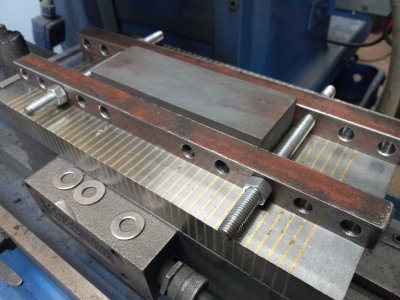TorontoBuilder
Sapientia et Doctrina Stabilitas
I dont have plans or a the time to mill nice comb shaped thin bent profiles to hold abrasive stones to the surface grinder for diamond grinding, so I whipped up a design I'm confident should work well enough.
This jig is specifically to hold Norton Crystolon/India combination bench stones but will work for any 2" x 6" stone.
1/2" x 2" x 6" cold rolled steel, milled flat and parallel, bored and threaded 10-24 at 2" o.c. from the center to allow side plates to be mounted. Then both sides will be given the slightest kiss in the surface grinder to true to the surface grinder using aluminum oxide wheel.
1/4" x 3/4" x 6.5" cold rolled steel, milled flat and parallel, bored, countersunk and threaded for 10-24 at 2" o.c. from the center to allow side plates to be mounted to main body. the the sides will be bored for seven holes located 2.75" o.c. from the centerline and threaded 4-40 for nylon tipped grub screws that will be used to hold the grinding stones securely to the jig while grinding.
I figure this is accurate and secure enough to provide the stones a level surface to a high level of precision.
Of course I'll mount the jig to the magnetic chuck

This jig is specifically to hold Norton Crystolon/India combination bench stones but will work for any 2" x 6" stone.
1/2" x 2" x 6" cold rolled steel, milled flat and parallel, bored and threaded 10-24 at 2" o.c. from the center to allow side plates to be mounted. Then both sides will be given the slightest kiss in the surface grinder to true to the surface grinder using aluminum oxide wheel.
1/4" x 3/4" x 6.5" cold rolled steel, milled flat and parallel, bored, countersunk and threaded for 10-24 at 2" o.c. from the center to allow side plates to be mounted to main body. the the sides will be bored for seven holes located 2.75" o.c. from the centerline and threaded 4-40 for nylon tipped grub screws that will be used to hold the grinding stones securely to the jig while grinding.
I figure this is accurate and secure enough to provide the stones a level surface to a high level of precision.
Of course I'll mount the jig to the magnetic chuck


